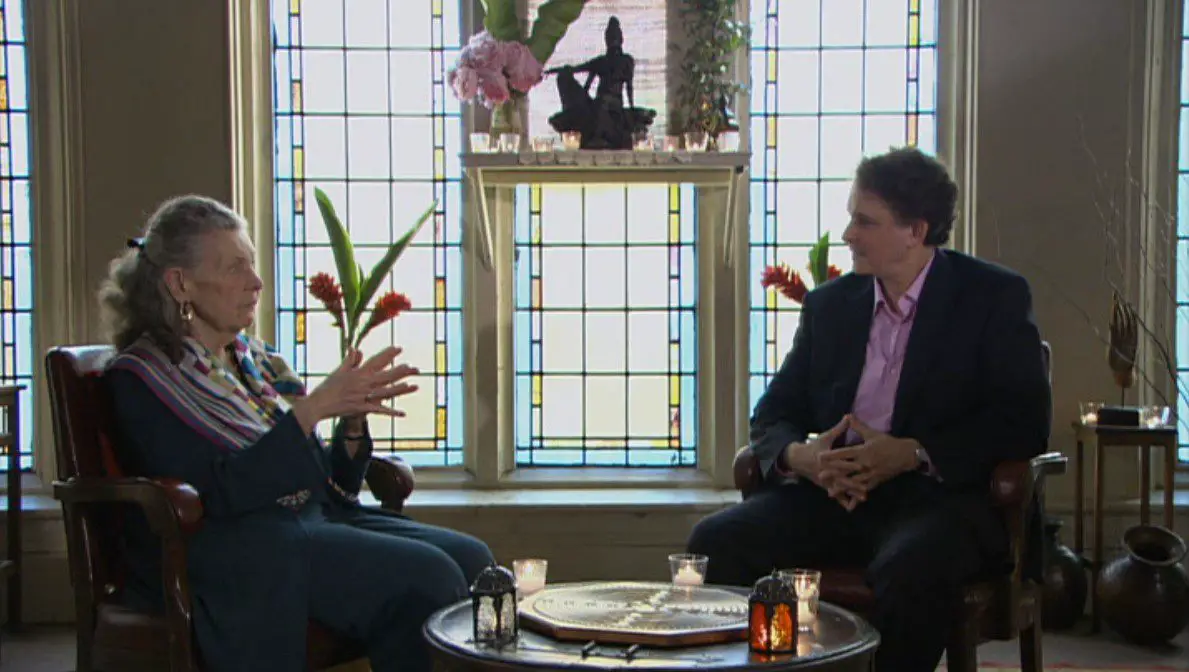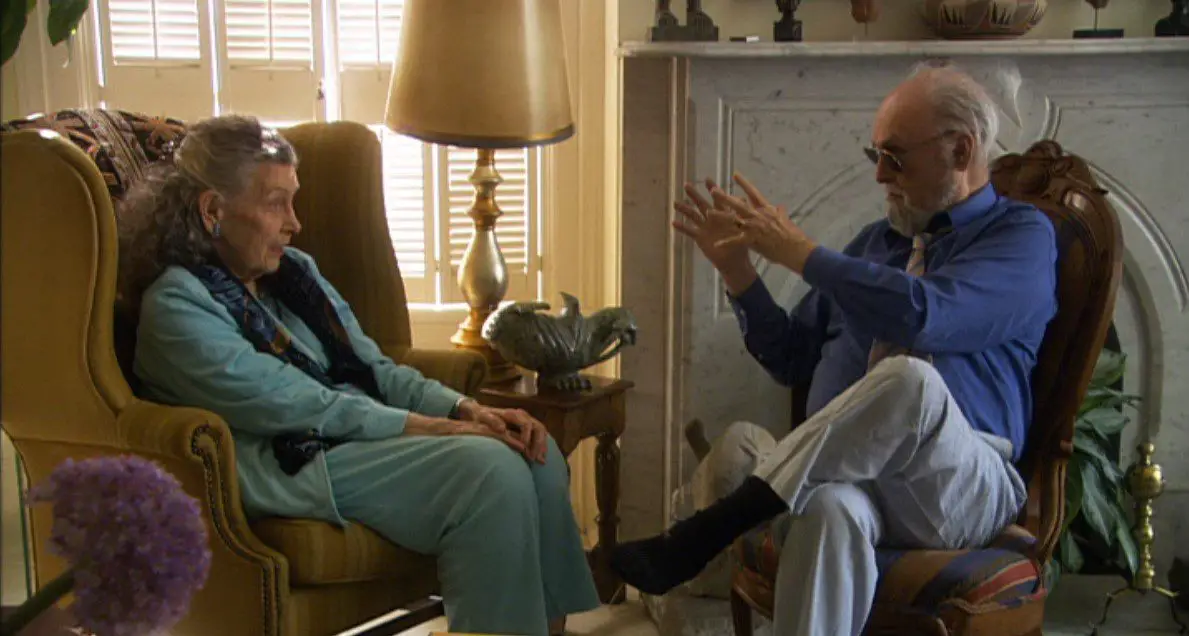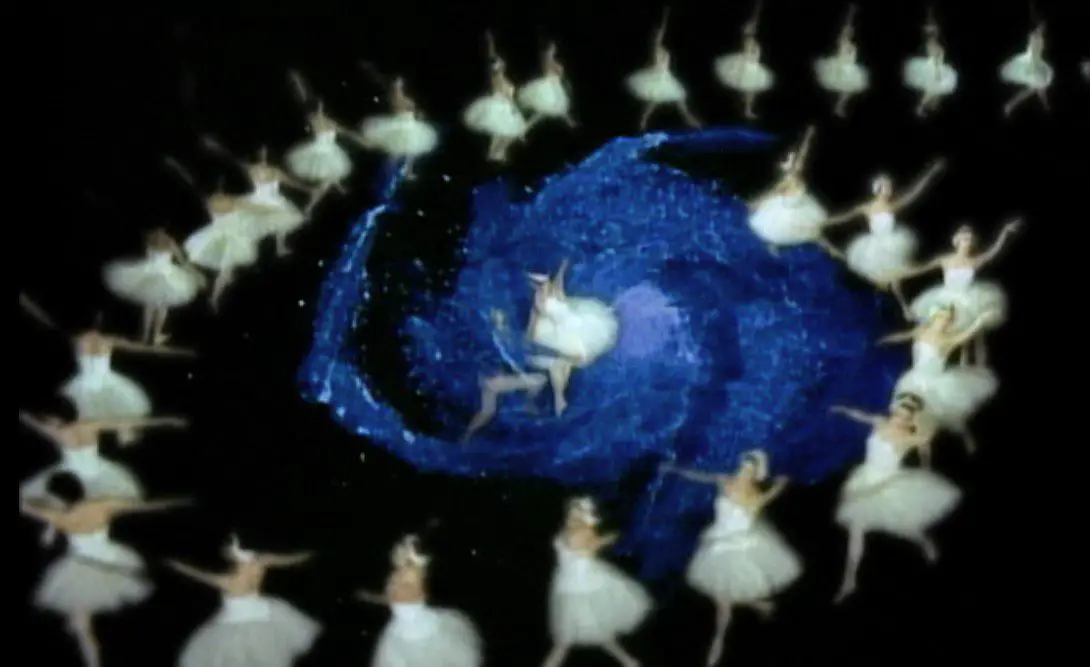Dancing in the Flames is a unique and powerful documentary about the life and work of Jungian analyst Marion Woodman. Until recently, this film was only available via DVD purchase, so I screened it for interested friends whenever I could, but fortunately it is now available for rent or purchase on Vimeo. I am relieved that this film exists, not only because I love Marion Woodman, but also because within a few years of its release, Woodman succumbed to dementia, which she lived with until she passed away in 2018.
If you aren’t familiar with her, Marion Woodman (1928–2018) was a Canadian Jungian analyst. She wrote several books, maintained an analytic therapy practice, facilitated BodySoul Rhythms groups, and lectured internationally. Throughout the 1980s, 1990s, and early 2000s, Woodman wrote articles and published books about eating disorders, perfectionism, the feminine principle, embodied dream work, illness, and intrapsychic femininity and masculinity, as well as many other subjects. As a whole, Woodman’s work focused on the body and embodied experience, which made her unique as a psychotherapist and especially as a Jungian analyst.
However, the film Dancing in the Flames, directed by Adam Greydon Reid, focuses less on Woodman’s professional accolades and instead delves into several pivotal moments of her personal life. These events all deal with life and death, both literally and metaphorically. Some of Woodman’s stories are, quite frankly, almost unbelievable. There are tales of serious (or terminal) illness and spontaneous healing, as well as a marriage that (psychologically) died and reformed four different times. There are also leftover bits in the “Special Features” of the DVD that include even more mind-boggling (but ultimately compelling) stories.
Dancing in the Flames begins with a slow, subtle wind. We see a cerulean spiral, perhaps a galaxy, floating in a void. Then, we hear Woodman’s wise, scratchy voice. She says,
I do believe we all have a destiny. We either live it or we escape because we’re afraid to live our own reality. I feel blessed. I didn’t really have choices. I have been forced through dreams, through my body responses, through illness, to surrender. The surrender feels like death. But if you’re going to live your full soul’s journey and find the spiritual dimension, you’re going to go this way, and surrender the old life to the new. I do not see surrender as failure at all, I would’ve simply died if I hadn’t seen that in the death was the birth of a whole new consciousness.

A great deal of Dancing in the Flames centers around an extended interview between Woodman and the British scholar of religion and mysticism, Andrew Harvey. A brightly lit stained-glass window frames their conversation, and a table covered candles and a small golden labyrinth sit nearby. Early on, Harvey admits that his descriptions of Woodman may sound “rather exalted” to the viewer, but he immediately says that what he loves about Marion is her down-home, direct, humorous, earthy nature. I think the same could be said of the interview setting. At times, it appears rather “transcendent,” or excessively spiritual. But once Woodman begins sharing the stories of her life, the luminous setting counterbalances the serious nature of the subject matter she is discussing. The presence of eating disorders, perfectionism, and death permeate her stories, which instantly dissolves any semblance of New Age grandiosity.
Dancing in the Flames also includes many snippets of Faith Hubley’s animations. Hubley’s work, which ranges from fluid and playful to desperate and stark, often serves to amplify and punctuate the film’s many interviews and conversations. Additionally, Jim McGrath’s evocative score also complements the tales of addiction, dreams, healing, and trauma from Woodman’s life. Taken together, these production elements artfully adorn Woodman’s world, but they also act as other speakers in dialogue with Woodman herself, resulting in a colorful and often unpredictable viewing experience.

It’s worth noting that many of the stories in this film are included in Woodman’s published works. For example, her story of illness and healing in India is included in The Pregnant Virgin, and her struggles with (and healing from) cancer are thoroughly detailed in Bone. However, there is something so immediate about Woodman’s live retellings of these stories. At times, Harvey is so entranced with Woodman that his mouth almost hangs open; he becomes completely receptive to her, and as we watch him watching her, so do we. As Woodman describes the many moments she approached the threshold of death and came back healed and transformed, he stares at her in awe, just as we do.
This film is punctuated by extremes; death is ever-present, but so is life. If I had to sum up the film in a single sentence, I would say that Dancing in the Flames utilizes Woodman’s lived experiences to convey the idea that life and death are inseparable and intertwined; in Woodman’s words, life and death “belong to each another.” The deaths discussed in this film refer to the “little deaths” of the soul, of life circumstances, of relationships and states of relationships, as well as the visceral death of the body. But as much as it emphasizes the reality of death, the film is dynamic; its players are electric and alive.
Woodman and her husband, Ross, as well as Andrew Harvey, all speak with clarity, authenticity, and power. They choose their words thoughtfully and speak with the full force of their being. They speak like poets and stage actors; their eyes are intense, their diction is precise, and they never flinch from the intensity of the discussion. As a viewer, it’s very stirring, almost jarring at times. Prior to viewing the film, I had never seen Woodman or heard her speak, but after I saw this film for the first time, I dreamed of her twice in a single night. Witnessing the intensity of her presence left a deep impression on me.

To give you a sense of how the other individuals in this film articulate their experience, here is a quote from Ross, after he is asked about meeting and eventually marrying Marion:
In one sense, in one very essential sense, I don’t think Marion and I ever met. I think we have always been together, like before the beginning and after the end. But I think there are some accidental things that happened in space and time in which we did seem to “come together” from the eternity in which we always already existed. . . You could almost say that vows were made. Not by either of us. We didn’t make the vows. But there was something hovering in the air, that there was a [with Marion] “destiny afoot!” It was then, as it were, a fate. But it might in time become a destiny.
Visually, my favorite moment in Dancing in the Flames occurs when Harvey and Woodman are discussing the cycles of creation and destruction in the universe. Harvey mentions that there is black hole at the center of our Milky Way galaxy that tears apart every molecule and atom it comes into contact with and rips it into nonexistence. He points out that this mysterious, destructive force is also what animates our galaxy and gives it life. The Milky Way spiral from the beginning of the film is overlaid on Woodman and Harvey; several ballet dancers appear, overlaid on the milky way, and they dance atop this cerulean swirl of destructive creativity. Woodman and Harvey seamlessly amplify the stories of a single life into the vastness and enormity of our cosmic situation, which is exemplified by the image of the dancers and the galaxy. In a way, this image and the final portion of their conversation sums up the entire film.

In one of the final scenes, Woodman sits and journals at her desk. Someone on the crew, perhaps Greydon Reid, asks her what she is writing. She exclaims, “Too late!” “What?” he asks. She immediately begins reading her journal aloud, which ends with the phrase “Too, too late!” Then, she forcefully says, “Uh!” The exclamation comes from a deep place in her gut, and she and the crew burst into laughter. She tosses down her glasses and her eyes light up. She smiles. She is smirking at herself, giggling at her own unabashed intensity. It’s a lovely moment where Woodman is not saying, “This is who I am,” rather, she is being it. In a way, this scene encapsulates what Dancing in the Flames is really about: Woodman’s commitment to being herself and living her life as authentically as possible, whatever the cost.



